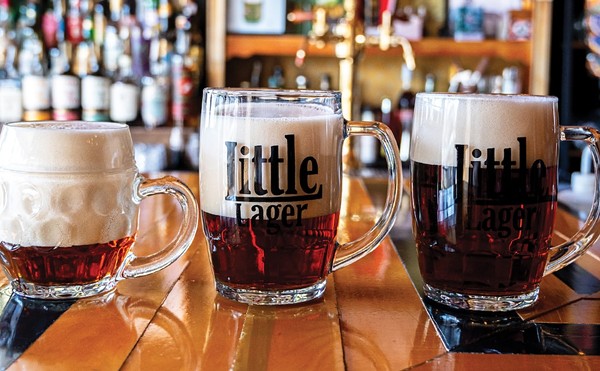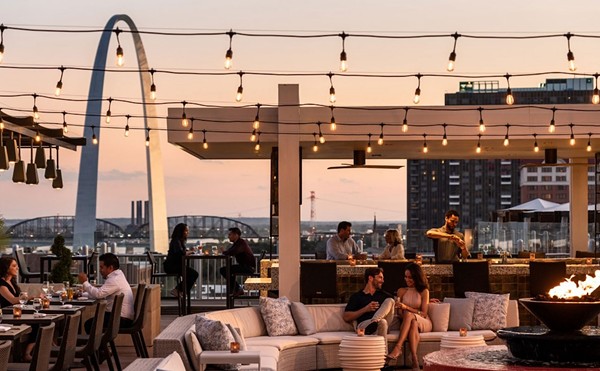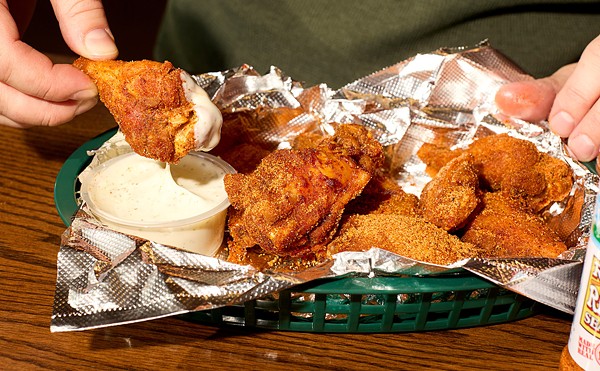Opening a good restaurant is miracle enough. I don't mean a four-star temple of haute cuisine or a bauble of glass and light the trend-humpers will pack for six months and then forget as quickly as they did last year's American Idol winner. I mean a comfortable, unpretentious place that serves flavorful food at reasonable prices. It's a miracle. And if that restaurant happens to introduce a somewhat sleepy Midwestern city to an unfamiliar cuisine — well, that's just gravy.
So when I heard last year that the Nepalese restaurant Everest Café & Bar was leaving its Washington Avenue address for Forest Park Southeast's Grove neighborhood, I was nervous.
The move is understandable. When Everest opened four years ago, you could imagine it as a frontier outpost as the gentrification of Washington Avenue moved west. Instead it remained the lone bright spot on a ramshackle block, its windows providing diners a view of the truly bizarre bombed-out, faux-Tudor strip across the street.
Still, there are certain things good restaurants do that always — always — set my alarm bell ringing: expand, open a second location, move. The hazards of expansion are well documented. If you add tables but don't make your kitchen bigger and hire more cooks, you can find yourself in the weeds every night, unconcerned with the quality of each plate, just wanting to get all the plates out. If you open another location, you can easily dilute the quality of the original. Send a few of your best cooks and servers to help launch the new place and suddenly you have two OK restaurants rather than one good one.
Moving is trickier. There are cursed locations, where even a great restaurant is doomed, but there are also restaurants that, in spite of a location like something out of Mad Max, persevere or even prosper. (Consider how long King Louie's lasted at a less-than-ideal intersection.) Yes, yes, I know. We're all rational adults here. But do you really want to mess with mojo?
So with no small amount of relief, I can report that Everest's new location has much of the original's diamond-in-the-rough charm. It helps that the Grove, though an up-and-coming commercial district, retains a certain grit. Everest is across the street from Atomic Cowboy and half a block from Novak's and the Church Key, but if you head not very far in the other direction, you end up in an underdeveloped stretch.
The interior is small, with a narrow bar area leading into the modest-size dining room. (There is another, even smaller room in the back.) The dining room's high ceiling keeps the space from feeling cramped. The décor is simple but distinctive, with an image of the Dalai Lama's face superimposed on Mount Everest its most striking feature.
At each place setting is a letter that describes the remarkable biography of owner and chef Devi Gurung States: As an orphaned teenager in Nepal, he moved to Kathmandu and, after a spell of homelessness, found work as a restaurant dishwasher and busboy. Then he met the American James States, a mountain climber and medical doctor who adopted Devi and brought him to the U.S.
Besides being a chef and restaurateur, Devi States holds graduate degrees in social work and public health. According to Everest's Web site (www.everestcafeandbar.com), diners' health is one of States' main concerns. For example, while Everest's sauces might remind you of Indian fare, they are made without ghee (clarified butter) or heavy cream. As my heart is larded with bacon, I'm the absolute last person to comment on healthy eating, but I'm glad someone else is looking out for me.
Those of you who have visited Everest so often that you have Devi States' story memorized will be happy to know that the food at its new Grove address remains as appealing as when my predecessor, Rose Martelli, raved about the original Everest ["Summit Kind of Wonderful," June 30, 2004].
India is a common reference point for Nepalese cuisine: Nepal borders India's north, where much of what Westerners consider Indian cuisine originates. Oddly, on my recent visits to Everest, the dish I found most reminiscent of Indian fare — leaving aside the obviously Indian or Indian-influenced dishes like vegetable pakora or saag paneer — was gorkhali chicken. This consists of boneless chicken chunks in what the menu describes as an "authentic Nepali-style sauce." Tomato-based with an acidic bite and definite heat, this was like a mild vindaloo sauce, a Goan dish from India's southwest coast.
The strongest link between the two cuisines is the alchemy of spices: cumin, coriander, turmeric, cinnamon, clove, ginger, garlic and more, blending together to form flavors both comforting and foreign. This was most apparent in the mixed vegetable tarkari with tofu, a blend of cauliflower, green beans and bell peppers in a light sauce with a very slight kick. The myriad spices brought depth to the plain-jane vegetables (not to mention the tofu), yet they didn't obscure the essential flavor of those vegetables (except, thankfully, the tofu).
Lamb sekuwa is cooked in a tandoori oven and served on a sizzling platter: thick chunks of boneless lamb with lemon wedges, tomato, red onion and bell pepper. Here, too, the spicing was just right, complementing the rich flavor of the lamb and providing contrast to the bite of the red onion and lemon juice. The lamb was particularly impressive, juicy and very tender. Sekuwa is also available with chicken or shrimp, or with all three meats.
Speaking of which, though the menu seems long, many of your choices are variations on a theme. There is, for example, chicken tarkari, chicken tarkari with spinach and chicken tarkari with mixed vegetables. Same with lamb. (There are also a few Korean dishes; States' wife, Connie, is Korean-American.)
I tried the chicken daal, bhat, tarkari ra saag, which the menu explains is a complete Nepali meal; if you've ordered the thali platter at an Indian restaurant, this will look familiar. Rice is served in the center of your platter; in separate compartments around it are your choice of meat, vegetables, pickled mango, lentil soup and individual slices of lemon and cucumber. The chicken was tender; in this case I detected cinnamon above the other spices. The lentil soup is wonderfully garlicky. Our server suggested using it as a sauce for the rice, and this became the highlight of the meal. Pickled mango adds a sharp note to whatever you pair it with.
Maybe the most well known of Everest's dishes are the mo-mos. These hail from Tibet, which is squeezed (literally and, sadly, politically) between Nepal and China, and are an excellent way to begin your meal. Seasoned ground pork is steamed inside a delicate dumpling. On the side is achar, a lovely sauce, rich and pungent, that elevates the mo-mo from snack to the sort of dish you should go out of your way to try.
Fortunately, the trip from Washington Avenue to the Grove won't take you very long.





